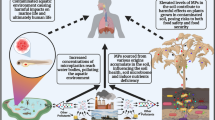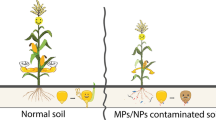Abstract
The effects of particles on the photosynthesis of vegetation, which is a sink for fine particulate matter (PM2.5) deposition, are still not well understood. Here, we carried out indoor measurements to evaluate the variation dynamics of net photosynthetic rate and stomatal conductance of four plant species with different leaf characteristics under different PM2.5 levels. Then tree leaves were sampled and the groove proportion, leaf trichome density, stomatal density and stomatal size were quantitatively studied by scanning electron microscopy (SEM). The stomatal conductance of the 4 species had a close positive correlation with photosynthetic rate. Net photosynthetic rate and stomatal conductance declined over time at elevated PM2.5, and the rate of the decline became more rapid with higher concentration of PM2.5. The inhibiting effect might be caused by the closure of the stomata and the decrease of stomatal conductance, which was proved by the reduction of the stomatal size of under the condition of PM2.5 pollution. Leaf trichome and groove seemed to show a protective role for plants from PM2.5 exposure and be responsible for the difference of photosynthetic rate and stomatal conductance under the condition of PM2.5 pollution. The higher groove proportion and the presence of trichomes on the leaf surface in Neolitsea aurata and Lindera kwangtungensis absorbed some particulate matters and buffered the effect of PM2.5 pollution on stomata.
Similar content being viewed by others
References
Ahn KH, Jung CH, Choi M, Lee JS (2001) Particle sampling and real time size distribution measurement in H2/O2/TEOS diffusion flame. J Nanopart Res 3:161–170
Baldocchi D, Meyers T (1998) On using eco-physiological, micrometeorological and biogeochemical theory to evaluate carbon dioxide, water vapor and trace gas fluxes over vegetation: a perspective. Agr Forest Meteorol 90:1–25
Baraldi R, Neri L, Costa F, Facini O, Rapparini F, Carriero G (2018) Ecophysiological and micromorphological characterization of green roof vegetation for urban mitigation. Urban For Urban Green 37:24–32
Bosco ML, Varrica D, Dongarra G. (2005) Case study: inorganic pollutants associated with particulate matter from an area near a petrochemical plant. Environ Res 99:18–30
Bukaveckas PA, MacDonald A, Aufdenkampe A, Chicks JH, Havel JE, Schultz R, Angradi TR, Bolgrien DW, Jicha TM, Taylor D (2011) Phytoplankton abundance and contributions to suspended particulate matter in the Ohio, Upper Mississippi and Missouri Rivers. Aquat Sci 73:419–436
Chai YX, Zhu N, Han HJ (2002) Dust removal effect ofurban tree species in Harbin. J Appl Eco l13:1121–1126
Cowan IR (1978). Stomatal behaviour and environment. Adv Bot Res 4:117–228
Escobedo FJ, Kroeger T, Wagner JE (2011) Urban forests and pollution mitigation: analyzing ecosystem services and disservices. Environ Pollut 159:2078–2087
Finer M, Jenkins CN, Pimm SL, Keane B, Ross C (2008) Oil and gas projects in the western Amazon: threats to wilderness, biodiversity, and indigenous peoples. Plos One 3:1–9
Gallagher MW, Nemitz E, Dorsey JR, Fowler D, Sutton MA, Flynn M, Duyzer J (2002) Measurements and parameterizations of small aerosol deposition velocities to grassland, arable crops, and forest: influence of surface roughness length on deposition. J Geophys Res 107:1–10
Gilmour PS, Ziesenis A, Morrison ER, Vickers MA, Drost EM, Ford I, Karg E, Mossa C, Schroeppel A, Ferron GA, Heyder J, Greaves M, MacNee W, Donaldson K (2004) Pulmonary and systemic effects of short-term inhalation exposure to ultrafine carbon black particles. Toxicol Appl Pharmacol 195:35–44
González JA, Prado FE, Piacentini RD (2014) Atmospheric dust accumulation on native and non-native species: effects on gas exchange parameters. J Environ Qual 43:801–808
Hirano T, Kiyota M, Aiga I (1995) Physical effects of dust on leaf physiology of cucumber and kidney bean plants. Environ Pollut 89:255–261
Hwang HJ, Yook SJ, Ahn KH (2011) Experimental investigation of submicron and ultrafine soot particle removal by tree leaves. Atmos Environ 45:6987–6994
Janssen NA, Van Mansom DF, Van Der Jagt K, Harssema H, Hoek G (1997) Mass concentration and elemental composition of airborne particulate matter at street and background locations. Atmos Environ 31:1185–1193
Kiyomizu T, Yamagishi S, Kume A, Hanba YT (2018) Contrasting photosynthetic responses to ambient air pollution between the urban shrub Rhododendron × pulchrum and urban tall tree Ginkgo biloba in Kyoto city: stomatal and leaf mesophyll morpho-anatomies are key traits. Trees 33:63–77
Larcher W (2003) Plant physiological ecology. Springer, Berlin.
Lehndorff E, Urbat M, Schwark L (2006) Accumulation histories of magnetic particles on pine needles as function of air quality. Atmos Environ 40:7082–7096
Liang D, Ma C, Wang YQ, Wang YJ, Chen-Xi Z (2016) Quantifying PM 2.5 capture capability of greening trees based on leaf factors analyzing. Environ Sci Pollut Res Int 23:21176–21186
Nowak DJ, Hirabayashi S, Bodine A, Hoehn R (2013) Modeled PM 2.5 removal by trees in ten US cities and associated health effects. Environ Pollut 178:395–402
Pal A, Kulshreshtha K, Ahmad KJ, Behl HM (2002) Do leaf surface characters play a role in plant resistance to auto-exhaust pollution? Flora 197:47–55
Popek R, Gawrońska H, Gawroński SW (2015) The level of particulate matter on foliage depends on the distance from the source ofemission. Int J Phytoremediat 17:1262–1268
Popek R, Gawrońska H, Wrochna M, Gawroński SW, Saebø A (2013) Particulate matter on foliage of 13 woody species: deposition on surfaces and phytostabilisation in waxes -a 3-year study. Int J Phytoremediat 15:245–256
Pryzybysz A, Popek R, Gawrońska H, Grab K, Łoskot K, Wrochna M, Gawroński SW (2014) Efficiency of photosynthetic apparatus of plants grown in sites differing in level of particulate matter. Acta Sci Pol Hortoru 13:17–30
Pryzybysz A, Popek R, Gawrońska H, Grab K, Łoskot K, Wrochna M, Gawroński SW (2014). Efficiency of photosynthetic apparatus of plants grown in sites differing in level of particulate matter. Acta Sci Pol Hortoru 13:17–30
Sæbø A, Popek R, Nawrot B, Hanslin HM, Gawronska H, Gawronski SW (2012) Plant species differences in particulate matter accumulation on leaf surfaces. Sci Total Environ 427:347–354.
Schaubroeck T, Deckmyn G, Neirynck J, Staelens J, Adrianenssens S, Dewulf J, Muys B, Verheyen K (2014) Multilayered modeling of particulate matter removal by a growing forest over time, from plant surface deposition to washoff via rainfall. Environ Sci Technol 48:10785–10794
Seigneur C, Pun B, Pai P, Louis JF, Solomon P, Emery C, Morris R, Zahniser M, Worsnop D, Koutrakis P, White W, Tombach I (2000) Guidance for the performance evaluation of threedimensional air quality modeling systems for particulate matter and visibility. J Air Waste Manage 50:588–599
Song Y, Maher BA, Li F, Wang X, Sun X, Zhang H (2015) Particulate matter deposited on leafoffive evergreen species in Beijing, China: source identification and size distribution. Atmos Environ 105:53–60
Terzaghi E, Wild E, Zacchello G, Cerabolini BEL, Jones KC, Di Guardo A (2013) Forest filter effect: role of leaves in capturing/releasing air particulate matter and its associated PAHs. Atmos Environ 74:378–384
Wang D, Heckathorn SA, Barua D, Joshi P, Hamilton EW, Lacroix JJ (2008) Effects of elevated CO2 on the tolerance of photosynthesis to acute heat stress in C3, C4, and CAM species. Am J Bot 95:165–76
Wong SC, Cowan IR, Farquhar GD (1985a) Leaf conductance in relation to rate of CO2 assimilation I. Influence of nitrogen nutrition, phosphorus nutrition, photon flux density, and ambient partial pressure of CO2 during ontogeny. Plant Physiol 78:821–825
Wong SC, Cowan IR, Farquhar GD (1985b) Leaf conductance in relation to rate of CO2 assimilation II. Effects of short-term exposures to different photon flux densities. Plant Physiol 78:826–829
Wong SC, Cowan IR, Farquhar GD (1985c) Leaf conductance in relation to rate of CO2 assimilation III. Influences of water stress and photoinhibition. Plant Physiol 78:830–834
Xu LK, Baldocchi DD (2003) Seasonal trends in photosynthetic parameters and stomatal conductance of blue oak (Quercus douglasii) under prolonged summer drought and high temperature. Tree Physiol 23:865–877
Zhang WK, Wang B, Niu X (2015) Adsorption capacity of the air particulate matter in urban landscape plants in different polluted regions of Beijing. Huan jing ke xue 36: 2381–2388
Zhao BX (2015) Influence of vegetation on PM2.5 reduction and retention based on different scales. Ph.D. thesis. Beijing Forestry University, Beijing
Author information
Authors and Affiliations
Corresponding author
Rights and permissions
About this article
Cite this article
Li, Y., Wang, Y., Wang, B. et al. The Response of Plant Photosynthesis and Stomatal Conductance to Fine Particulate Matter (PM2.5) based on Leaf Factors Analyzing. J. Plant Biol. 62, 120–128 (2019). https://doi.org/10.1007/s12374-018-0254-9
Received:
Accepted:
Published:
Issue Date:
DOI: https://doi.org/10.1007/s12374-018-0254-9




